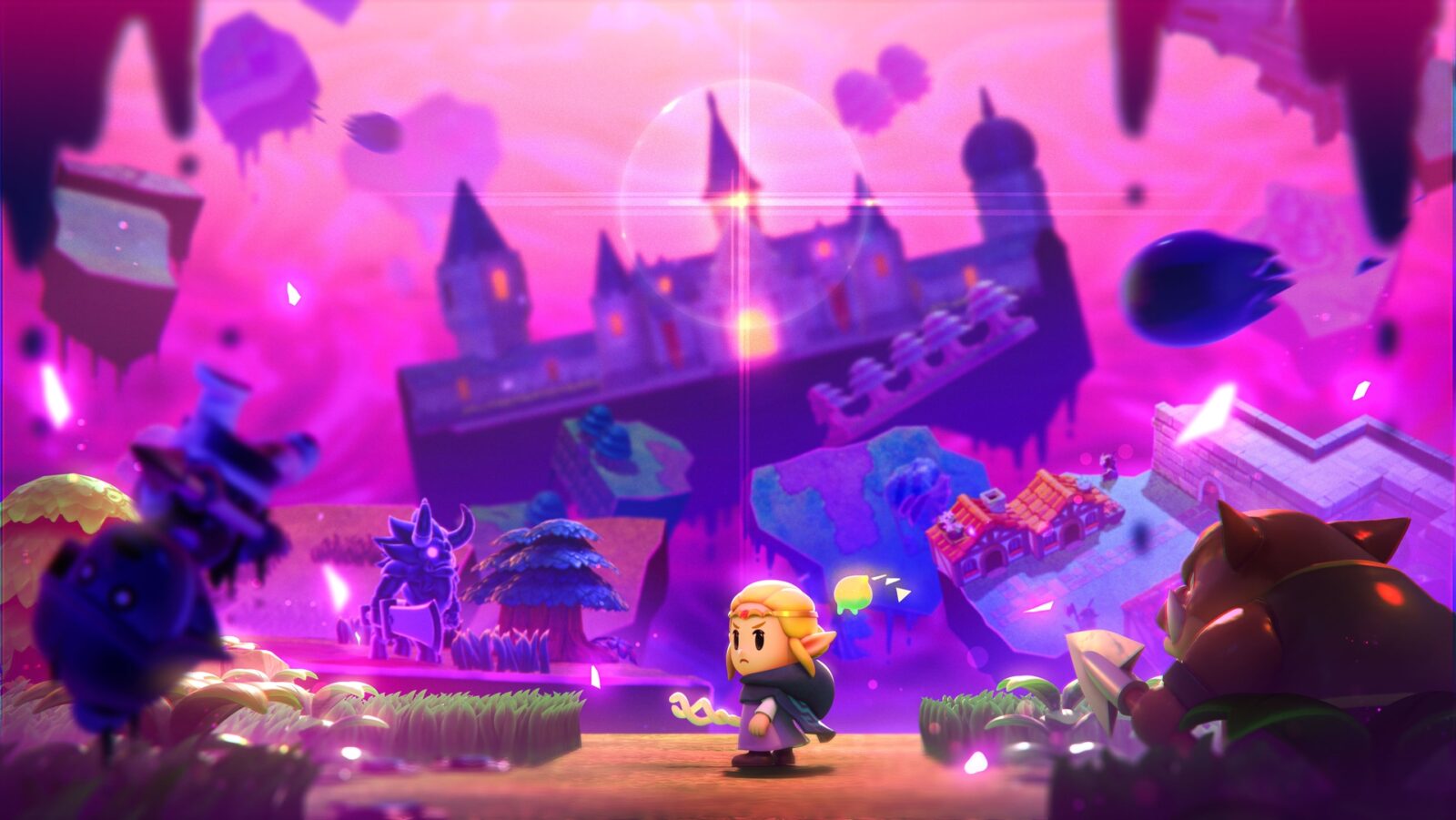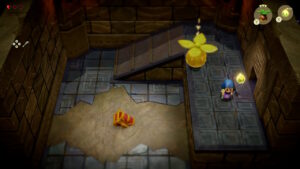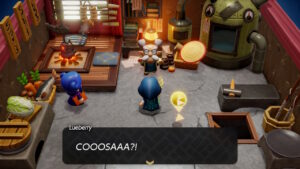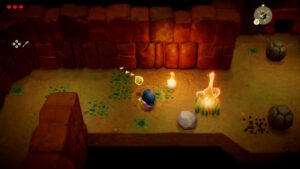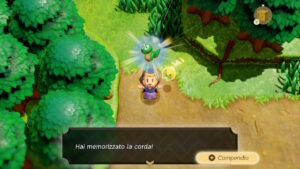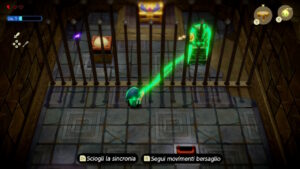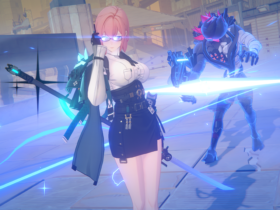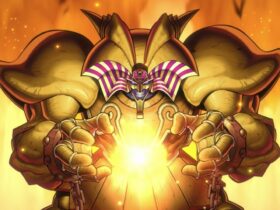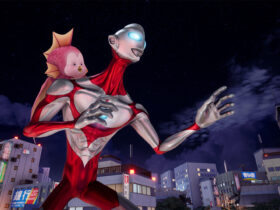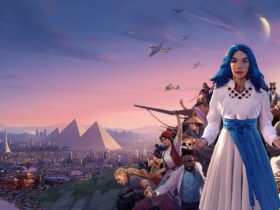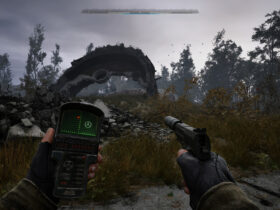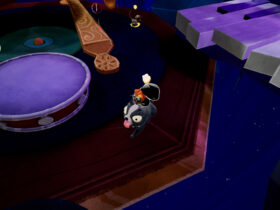I don’t hide the fact that I approached The Legend of Zelda: Echoes of Wisdom with a certain degree of scepticism. The classic setting, the integration of iconic elements from the saga, and the familiarity with the established formula across all Nintendo consoles suggested that it would be a pleasant nostalgic throwback, but nothing particularly revolutionary. Yet again, the creativity of Aonuma and the development team has managed to surprise me pleasantly. Princess Zelda, usually relegated to the role of damsel in distress, reveals herself as a complex and fascinating heroine: her determination and original combat abilities won me over from the very first moments, while the so-called Replicas system, which allows her to manipulate the environment and summon (almost) creatures and objects from thin air, adds a strategic depth never previously experienced in other instalments of the franchise.
The game world, while evoking familiar settings, is rich with new details and innovative mechanics. The explorable surface of Hyrule turned out to be a vibrant and pulsating place, where every corner hides surprises of all kinds. I especially appreciated the fluidity in transitioning from pure exploration to intense action sequences, despite some technical uncertainties that Echoes of Wisdom inherits, albeit to a lesser extent, from the previous remake of Link’s Awakening, along with the care taken in crafting puzzles that often require unconventional approaches and once again deserve to be called such. It would therefore seem reductive to define it as a simple return to the origins, but it might also be daring to present it as an absolute natural evolution, given that it commendably manages to combine classic elements with astonishing innovations. The aim I have set for this review is therefore to try to explain in detail, assuming you don’t rush to sneak a peek at the score, whether all these fantastic premises manage to remain fresh and engaging until the end, or if they run out of surprise after a short while and lead the adventure onto somewhat conventional tracks.
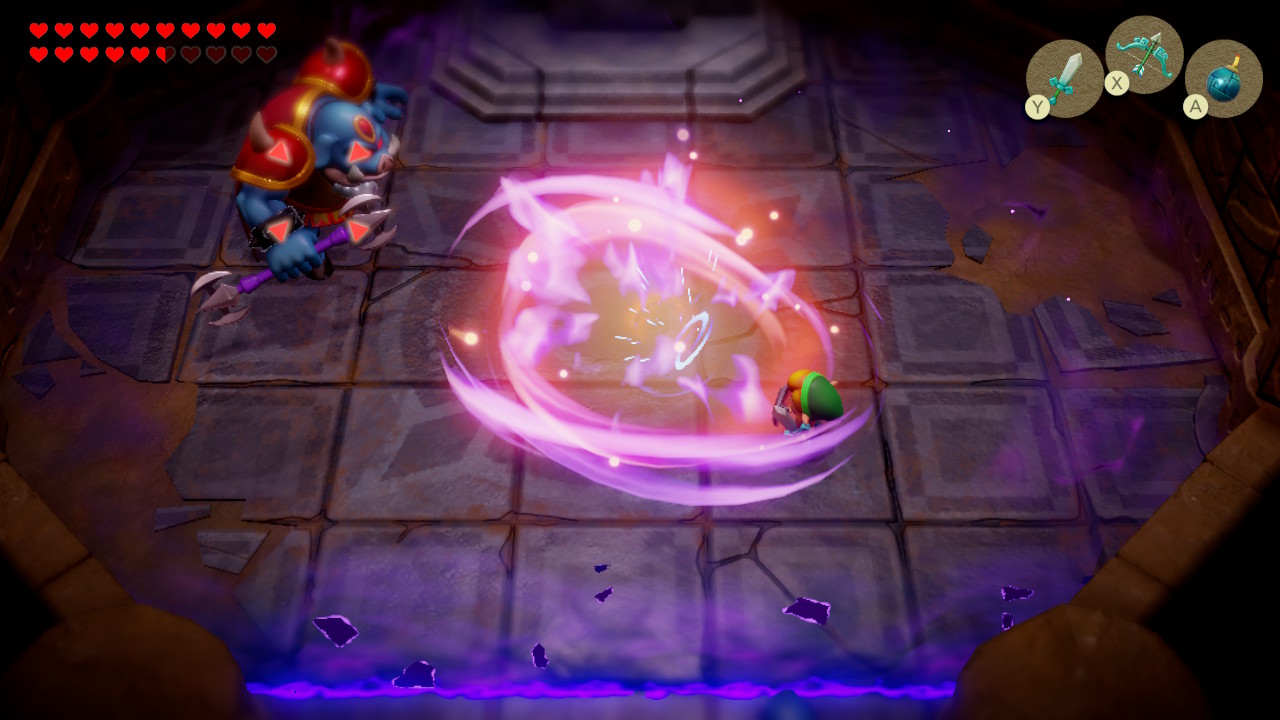
The Legend of Zelda: Echoes of Wisdom — A Place in a Timeless World
First, let’s bravely tackle the colossal Vah Ruta head-on: where can we place Echoes of Wisdom within the tangled timeline of The Legend of Zelda? Without dwelling too much on the plot details, I can confirm that its exact location remains uncertain even after seeing the credits roll, as Nintendo intentionally intended. Therefore, all we can do is speculate along which timeline our princess’s journey moves based on the details gathered during the game. The theory that many seem to agree on, myself included, is that this new chapter may represent a reimagining of the origins of the so-called timeline of the Defeated Hero, named so by the voluminous Hyrule Historia, the first official attempt by the Great N to reorganize decades of notes, documents, annotations, and reminders created during the development of each Zelda instalment. The theory is based on various elements, starting from the aesthetics and design of Hyrule which bear notable similarities to A Link to the Past, a title that falls precisely within this series of events and follows Link’s defeat at the hands of the Demon King Ganon. Moreover, Ganon’s appearance closely resembles his incarnations in Oracle of Ages/Seasons and A Link Between Worlds, reinforcing the hypothesis of a connection to this narrative branch. However, one element seems to contradict this speculation, namely that Ganon is defeated by Link at the start of the game: in the aforementioned chronology, the Demon King usually has the upper hand against Link, taking possession of the Triforce and unleashing chaos. In Echoes of Wisdom, however, it appears that Link prevails, and this discrepancy could be due to a plot error, a preview of an event yet to come, or even a complete reinterpretation of the story.
Another interesting and quite popular hypothesis among fans views the new chapter as a direct sequel to Link’s Awakening, and the reasons supporting this are numerous, starting from the artistic style and overall atmosphere that bear significant similarities to the previous remake, an explicit choice that could represent a clear reference. Secondly, the presence of both types of Zora, both marine and riverine, is an apparent detail that does not go unnoticed. This feature, already present in the two Oracle games, could indicate a narrative continuity with the events of Link’s Awakening and Link’s subsequent adventures in Labrynna. On the other hand, this theory also presents some inconsistencies, particularly the premature appearance of Ganon, who should not manifest in Hyrule before the events of the subsequent A Link Between Worlds, coupled with the presence of the Great Deku Tree, which perished during Ocarina of Time and regrew before the start of The Wind Waker, yet belongs to a different timeline and therefore undermines the direct connection between Echoes of Wisdom and Link’s dreamlike odyssey on Koholint Island. A third theory imagines a complete rethinking of the Zelda timeline, a scenario in which this new chapter does not fit into any of the existing branches (Defeated Hero or Triumphant Hero), nor into the original progression that goes from Skyward Sword to Ocarina of Time, or into that created after the reconnection of the previous timelines in Breath of the Wild and Tears of the Kingdom. What if Echoes of Wisdom opens a new temporal branch, completely disconnected from everything we have seen so far? It may seem a shocking idea for the most devoted fans, but upon reflection, it isn’t as implausible as it could explain various contradictions, the visual differences in Hyrule’s landscape, Ganon’s unusual appearance, and even the nature of Link’s sword. A convenient solution, certainly, but one that could allow Nintendo to bypass some of the narrative complexities that the series has carried over the years, and perhaps normalize this peculiar reversal of the traditional roles held by the two protagonists.
The Legacy of a Hero, the Fate of a Princess
Putting aside the intriguing musings about the placement of this episode in the series’ chronology, a point that the development team has always paid little attention to, let’s return to the core of our review to emphasize how The Legend of Zelda: Echoes of Wisdom represents a genuine turning point in the franchise, a bold attempt to reinvent a formula that has made history in video games. Abandoning the vastness of the open worlds explored in Breath of the Wild and Tears of the Kingdom, Nintendo takes us back to the two-dimensional roots of the series, but with a completely renewed vision. In this new chapter, it’s Zelda who takes charge of the adventure. Armed with a magical staff of almost unlimited potential, the princess of Hyrule explores a world full of mysteries and dangers. The gameplay, while maintaining the essence of classic Zelda, introduces new elements that make it unique. The ability to manipulate the environment, create objects, and solve puzzles through various approaches transforms each screen into a small sandbox to explore. Initially, our instincts push us to use the sword, a now-iconic action of the series, but the game encourages us to explore new dynamics, utilizing Zelda’s unique abilities and the peculiarities of the scenarios. For instance, we can interact with enemies in unexpected ways and opt for more elaborate tactics instead of facing them head-on, such as luring them into traps we build or using creatures with ranged attacks to hit them from afar.
Echoes of Wisdom is not merely a return to the past; it is a natural evolution of the series. The title draws from the rich tradition of Zelda, revisiting iconic elements such as intricate dungeons, memorable bosses, and the constant feeling of discovery, but reinterprets them in a modern way. The result is an experience that, while deeply rooted in the saga’s past, manages to offer a breath of fresh air and satisfy even the most demanding players. When we compare this new chapter to previous ones, the distinction is immediately apparent. Breath of the Wild and Tears of the Kingdom accustomed us to a vast and open world where the freedom of exploration was absolute. Echoes of Wisdom, on the other hand, offers a more confined crossroads, but no less varied. Here, the focus is on puzzle-solving, discovering hidden secrets, and interacting with the surrounding environment. It is a return to the origins, yet with an awareness and maturity that only years of experience can provide. Echoes of Wisdom is a game that invites us to reflect on the very concept of freedom in a video game. The ability to explore a vast and open world in complete autonomy is certainly fascinating, but it is not the only form of independence at our disposal. Throughout Princess Zelda’s ordeal, emancipation is expressed through the ability to interact creatively with the environment, find original solutions to puzzles, and craft our path. It is a concept of freedom that is more intimate, more personal, inviting us to test our intelligence and imagination in ways that only Tears of the Kingdom had previously tried (and succeeded wonderfully) to do, though in different proportions.
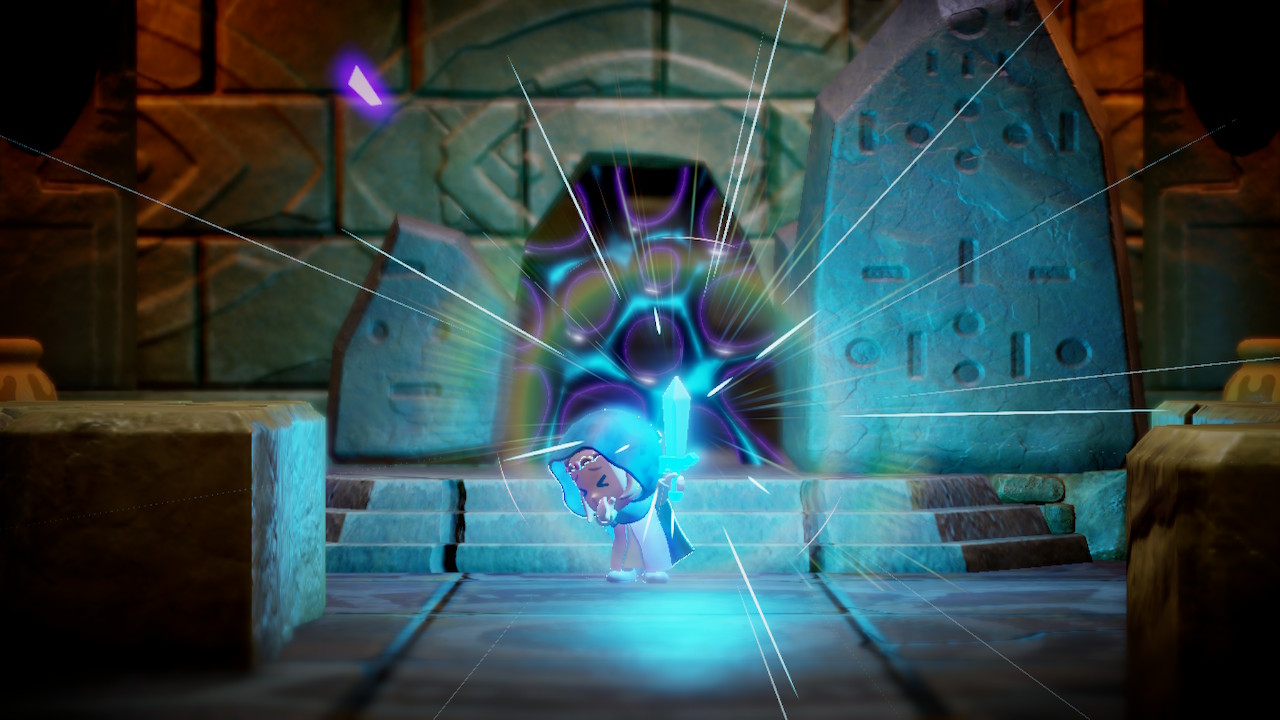
A Kingdom Forged from Ancestral Power
The ability to wield the sword, an authentic icon of the series, represents a significant turning point in our gameplay. However, this new ability is closely tied to the defeat of a dark doppelgänger of Link, who, once neutralized, yields his arsenal to us. The swordsman form, in addition to granting us new moves and agility, introduces an interesting gameplay mechanic: the sword’s energy. This limited resource forces us to moderate the use of this powerful weapon, encouraging us to explore alternative tactics. The Tri Staff, Zelda’s magical sceptre capable of channelling her innate wisdom, remains a fundamental tool for facing the challenges ahead. Its versatility, allowing us to summon a wide range of creatures and objects, makes it an irreplaceable companion. Unlike the sword, the Tri Staff has no energy limitations, offering us greater creative freedom, but its charges are regulated by the power of Tri, the little fairy who gifts us the sceptre and accompanies us on our journey to close the rifts appearing all over Hyrule, preventing us from summoning vast quantities of monsters and paraphernalia. Echoes of Wisdom encourages us to explore and experiment.
The range of possibilities granted is truly broad, inviting us to find creative solutions to problems. The freedom to combine different abilities and items, coupled with inspired high-level design, ensures continual engagement, as well as heterogeneous approaches that often lead to unusual resolutions: without revealing too much, at one point I found myself needing to ignite two braziers to unlock access to a dungeon. Having not retrieved the Zol Igneo, a monster that produces fire and can burn flammable objects, and since one of the braziers was already lit, I decided to create a series of wooden beds to carry the flames to the extinguished one and proceed. The flexibility offered reminded me on more than one occasion of the best experiments conducted in Tears of the Kingdom, although I was disappointed that I couldn’t build a robot made of tables, statues, crates, and assorted crockery.
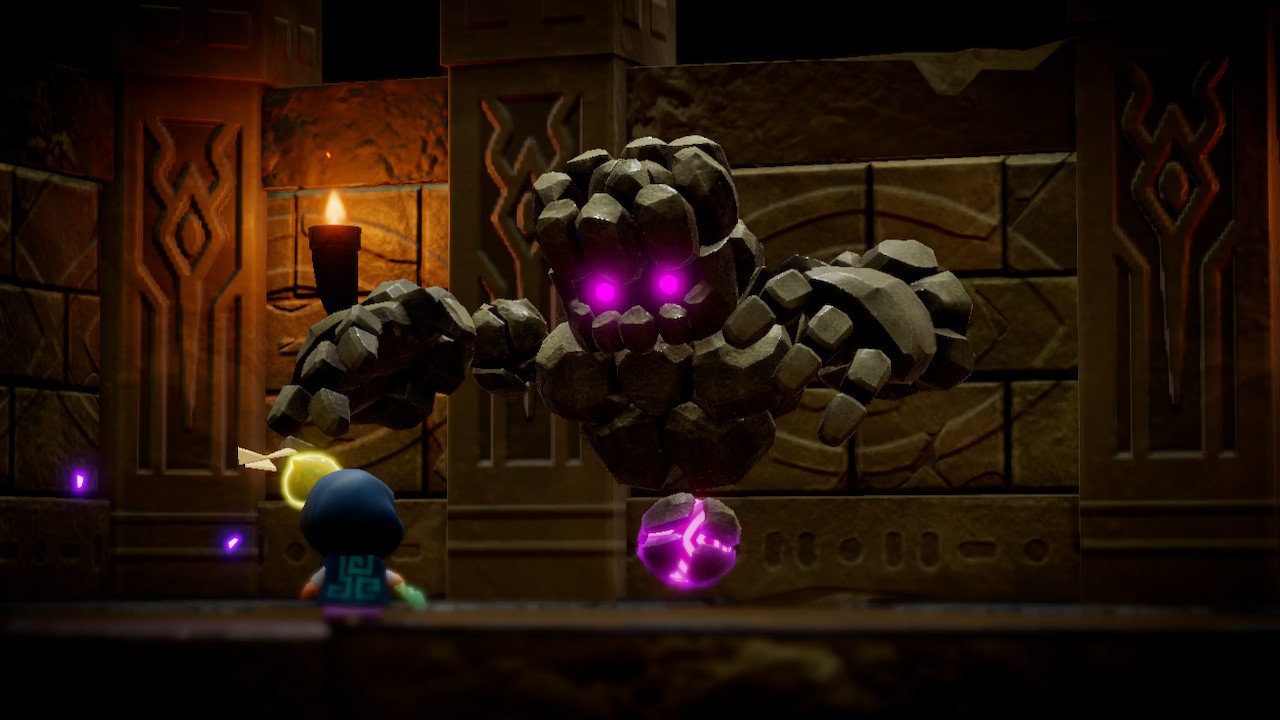
The Legend of Zelda: Echoes of Wisdom — Nostalgia for a Past Future
The various dungeons present in the game, which primarily follow a classic setting, serve as thorough testing grounds for the new gameplay mechanics. The inspired design and attention to graphical characterization provide a rich overall experience. The attention to detail is evident from the moment we first take control of Zelda: the textures are pleasing and detailed, the animations are fluid, and the character models are well-defined. All of this immerses the player in a lively, vibrant world. The most notable novelty lies in the variety of tools available to the player. Rather than relying on a single object or weapon to overcome challenges, players are called upon to experiment with an ever-expanding arsenal. Each room of the dungeon thus becomes a small laboratory, stimulating creativity and problem-solving in original ways. The depth of gameplay is amplified by the ability to combine different objects and abilities, opening the door to innovative and personalized solutions. The outside world, significantly larger than previous two-dimensional chapters of the series, also offers ample space for exploration. The ability to climb walls and trees using echoes revolutionizes how players interact with the environment. The level design, inspired by the series’ beginnings, is well-structured and offers a gradual progression, with increasingly complex and challenging puzzles.
One of the most persistent questions that bounced around my head while playing was about the game’s progression. With such freedom of movement, I wondered how they would manage the unfolding of events toward the inevitable final confrontation? The introduction of elements that invite experimentation, such as the ability to use environmental objects to solve puzzles or even heal the character, are naturally part of the aforementioned freedom the creators wanted to grant us, but they also pose real challenges in terms of gameplay balance, with the risk of “breaking” what should be the natural sequence of missions lurking around the corner. Fortunately, that was not the case, and even the “smartest” Replicas performed their task without giving me opportunities beyond my reach, like allowing access to places I should have only entered after completing a certain percentage of the story. In this regard, the structure of said storyline is rigorous yet engaging, allowing us to experience the events while feeling like active participants, something that has been partly lacking in the last two 3D instalments of The Legend of Zelda. While we’re at it, I feel compelled to make one note about the management interface of the Replicas, which becomes quite cumbersome once we’ve accumulated several dozen, making it seem absurd that the developers didn’t think of better categorizing them or a simple radial menu where we could add and replace our favourites.
From a technical standpoint, the game features high-quality graphics inherited from the remake of Link’s Awakening. The artistic style, characterized by vivid colours and careful details, fits perfectly with the game’s evocative atmosphere. However, there are noticeable frame rate drops, especially in more crowded areas or during graphically intensive sequences, where the game alternates between 30 and 60 fps to maintain a certain overall stability. Though they do not detract from the gaming experience, they may be annoying to more demanding players, although their presence is not as bothersome as in Link’s adventures on the island of Wind Fish. Also deserving of a mention are the music composed and arranged by Hajime Wakai, a veteran of Nintendo who has already gifted us the unforgettable tracks from Breath of the Wild and Tears of the Kingdom, and who in Echoes of Wisdom does a similarly commendable job, managing to even surpass himself in some instances with melodies that are majestic and enchanting, interspersed with joyful callbacks to the classic themes we’ve come to know from countless predecessors.
Echoes of Wisdom is a small epic that captures the adventurous spirit of the early Zelda chapters, paired with innovative and engaging gameplay. Its Hyrule, rich with mystery and magic, intricate dungeons to explore, complex puzzles to solve, and ever-new challenges, combines classic elements with modern mechanics to turn this chapter into a true gem. Despite a few minor technical glitches, Echoes of Wisdom confirms itself as an epic, fairy tale-like, and memorable adventure, truly unmissable for those who, orphaned by Tears of the Kingdom, have continued to search for another title that similarly tested their inventiveness and creativity. Nintendo has managed to craft an ode to the Zelda series, skilfully combining tradition and innovation, which both fans and newcomers would do well not to miss.


